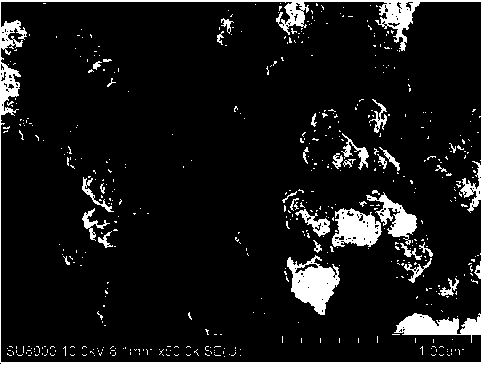Method for loading metal organic skeleton structure with noble metal nano-particles
A metal-organic framework and nanoparticle technology, applied in chemical instruments and methods, organic compound/hydride/coordination complex catalysts, physical/chemical process catalysts, etc., can solve the problems of cumbersome operation steps and long preparation period.
- Summary
- Abstract
- Description
- Claims
- Application Information
AI Technical Summary
Problems solved by technology
Method used
Image
Examples
Embodiment 1
[0022] Preparation of nanocomposite structures based on one-step method of loading noble metal nanoparticles in MOFs.
[0023] (1) By reducing Cu 2+ The method of hydroxy complexes to obtain cuprous oxide.
[0024] (2) Disperse cuprous oxide in N,N-dimethylacetamide (DMA) to form a 0.15mg / ml cuprous oxide DMA dispersion, and introduce a concentration of 80mM into the cuprous oxide DMA dispersion Trimellitic acid ethanol solution, and finally inject 100 microliters of 10mM chloroauric acid (HAuCl 4 ) ethanol solution, the mixed system was evenly mixed by shaking, and left to stand for 30 minutes. The obtained product was separated by centrifugation, washed 3 times with ethanol, and vacuum-dried at 50 degrees for 10 hours to obtain the MOFs nanocomposite structure supported by Au nanoparticles.
[0025] The scanning electron microscope picture of the reducing template cuprous oxide of the present embodiment is as follows figure 2 Shown; The scanning electron microscope pictu...
Embodiment 2
[0027] Preparation of nanocomposite structures based on one-step method of loading noble metal nanoparticles in MOFs.
[0028] (1) By reducing Cu 2+ The method of hydroxy complexes to obtain cuprous oxide.
[0029] (2) Disperse cuprous oxide in N,N-dimethylacetamide (DMA) to form a 0.15mg / ml cuprous oxide DMA dispersion, and introduce a concentration of 80mM into the cuprous oxide DMA dispersion Trimellitic acid ethanol solution, and finally inject 100 microliters of 10mM chloroplatinic acid (H 2 PtCl 6 ) ethanol solution, mix the mixed system evenly by shaking, and let it stand for 30 minutes. The obtained product is separated by centrifugation, washed 3 times with ethanol, and vacuum-dried at 50 degrees for 10 hours to obtain a Pt nanoparticle-loaded MOFs nanocomposite structure.
Embodiment 3
[0031] Preparation of nanocomposite structures based on one-step method of loading noble metal nanoparticles in MOFs.
[0032] (1) By reducing Cu 2+ The method of hydroxy complexes to obtain cuprous oxide.
[0033] (2) Disperse cuprous oxide in N,N-dimethylacetamide (DMA) to form a 0.15mg / ml cuprous oxide DMA dispersion, and introduce a concentration of 80mM into the cuprous oxide DMA dispersion Trimellitic acid ethanol solution, finally inject 100 microliters of 10mM potassium chloropalladate (H 2 PtCl 6 ) solution, mix the mixed system evenly by shaking, and let it stand for 30 minutes. The obtained product is separated by centrifugation, washed 3 times with ethanol, and vacuum-dried at 50°C for 10 hours to obtain a MOFs nanocomposite structure supported by Pd nanoparticles.
PUM
 Login to View More
Login to View More Abstract
Description
Claims
Application Information
 Login to View More
Login to View More - R&D Engineer
- R&D Manager
- IP Professional
- Industry Leading Data Capabilities
- Powerful AI technology
- Patent DNA Extraction
Browse by: Latest US Patents, China's latest patents, Technical Efficacy Thesaurus, Application Domain, Technology Topic, Popular Technical Reports.
© 2024 PatSnap. All rights reserved.Legal|Privacy policy|Modern Slavery Act Transparency Statement|Sitemap|About US| Contact US: help@patsnap.com










